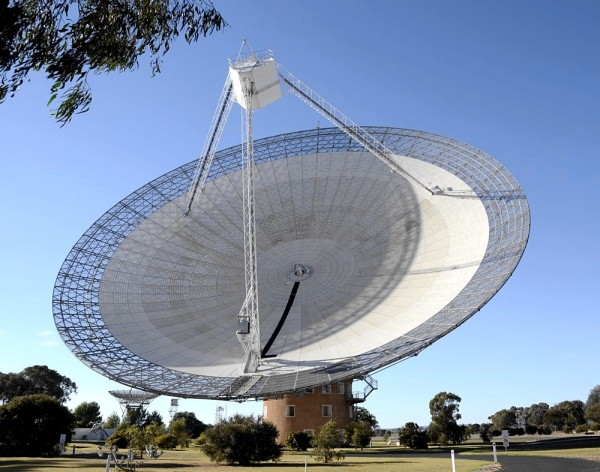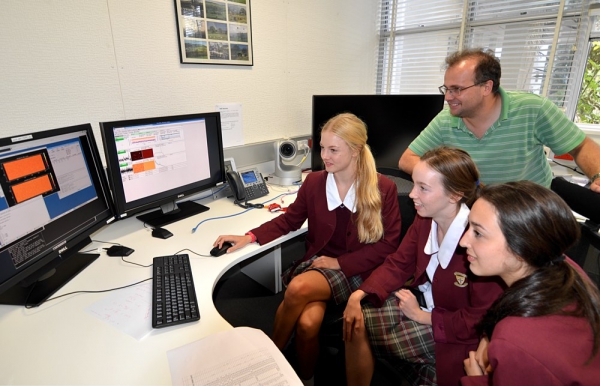by Robert Hollow
- Published: Friday, April 25 2014 07:06
We are half-way through our observing session, the high schools students are relaxing and getting more familiar with operating the iconic 64m Parkes radio telescope. They have just selected another pulsar to observe. They check that the calibrator signal is OK before slewing to the pulsar itself. As the data streams down a pulse profile appears on the screen. The pulsar is on! As they keep observing however it suddenly seems to disappear - the pulsar has turned off. One of the students turns to the professional astronomer overseeing the session: "Why does it do that?" she asks. "Why don't know" he replies. The student is somewhat stunned. "What do you mean you don't know?" she inquires. "Well if we knew we wouldn't need to keep observing and gathering data. This is real science. Science is not what we know but a way of trying to solve what we don't".
 The 64m CSIRO Parkes radio telescope
The 64m CSIRO Parkes radio telescope
This exchange gets replicated in most observing sessions we run as part of an innovative program for high school students, [email protected] (http://pulseatparkes.atnf.csiro.au/). Sooner or later one of the students gathers sufficient courage to ask THE question and the group is more often than not stunned by the unexpected answer.
[email protected] is one of the many projects globally that give expose students to real observations and data in astronomy. Students visit our Science Operations Centre at the headquarters of CSIRO Astronomy and Space Science in Sydney, Australia where they have two hours of dedicated telescope time and drive the telescope from the same desk and using the same systems as professional astronomers use. They observe pulsars, some of the most extreme objects in the Universe. Working in groups of three or four they determine which pulsars in a project catalog are currently observable with the telescope then observe a couple for several minutes.

Students observing pulsars with the Parkes radio telescope from the Science Operations Centre in Sydney with [email protected] astronomer Dr George Hobbs\
Once they have their data the students move out of the control room to the adjacent interaction space and start to analyse it. We usually have a few of our pulsar astronomers and PhD students available to assist them and answer questions. Currently we have an online module which students use to determine the distances to their pulsars. More modules are planned. Whilst working with their data they have ample time to talk with our staff and students about pulsars in particular, anything astronomical, science in general and science careers and study. This interaction between school students and professional scientists is an integral part of the program and one of the key impacts on the students.
 A screenshot of live data from the pulsar J1453-6413
A screenshot of live data from the pulsar J1453-6413
As telescope time is valuable once one group has completed observations another group that has been shadowing them swaps places and starts another set of observations. All the data obtained is publicly and freely available on our data archive so the students or anyone else can access it via a web browser later. The data is also useful in our ongoing pulsar programs such as the search for gravitational waves (http://www.atnf.csiro.au/research/pulsar/ppta/) and in support of the Fermi Gamma-ray Space Telescope pulsar studies.(http://fermi.gsfc.nasa.gov/).
As the project has developed so too has social media evolved. We now use Twitter to share our observing sessions with anyone interested in following. During one session we had followers in the US, UK and Brazil asking questions of our astronomers. You can follow along @PULSEatParkes. We also stream the data live via a web browser in each observing session so anyone online can view the telescope webcam and see the data. Future plans are likely to see us run interactive public sessions via webcasts.
The program has been running since late 2007 and to date over 1,100 high school students from about 100 schools have controlled the Dish. Whilst most sessions have been held in Sydney we've run others in other States of Australia and from several other countries including the UK, Netherlands and Japan (http://csirouniverseblog.com/2013/05/20/pulseparkes-in-japan/). Sharing our national facilities with overseas students is always a wonderful experience and demonstrates the potential of international linkages.
As I've already indicated, [email protected] is but one example of an increasing number of projects designed to expose students to and engage them with real telescopes and data. The NITARP scheme run by IPAC and NASA provides a detailed list of many of these around the world http://nitarp.ipac.caltech.edu/page/other_epo_programs. The growth of facilities such as the LCOGTN (http://lcogt.net/) described by Ed Gomez in his blog post on this site a few days ago (http://astronomerswithoutborders.org/gam-2014-blog/item/telescopes-in-exotic-places.html) opens up an increasing range of opportunities and activities for schools and students to engage with. Citizen science projects such as the diverse range offered by The Zooniverse (https://www.zooniverse.org/) provide another means for anyone to tackle real data.
If you are an educator who is yet to try some of these with your students don't be afraid to give them a go. You don't need to be an expert, just keen and open to challenges. If you are a student, try some of them out yourself or bring them t the attention of your teachers. Real science is not always smooth or easy but it is always engaging and stimulating. Don't expect clear-cut answers though. Mind you, with you working with some data and tackling problems you may help answer some, even if in the process you generate even more questions!
###
 Robert Hollow is the Education and Outreach specialist with CSIRO Astronomy and Space Science (http://www.atnf.csiro.au/) and has extensive background in teaching and astronomy education. Rob writes for the [email protected] blog: http://csirouniverseblog.com/. He is a member of the IAU's Office of Astronomy for Development Task Force for Astronomy for Children and Schools and is also the Chair of the Steering Committee of the Education and Public Outreach Chapter for the Astronomical Society of Australia.
Robert Hollow is the Education and Outreach specialist with CSIRO Astronomy and Space Science (http://www.atnf.csiro.au/) and has extensive background in teaching and astronomy education. Rob writes for the [email protected] blog: http://csirouniverseblog.com/. He is a member of the IAU's Office of Astronomy for Development Task Force for Astronomy for Children and Schools and is also the Chair of the Steering Committee of the Education and Public Outreach Chapter for the Astronomical Society of Australia.








Comments